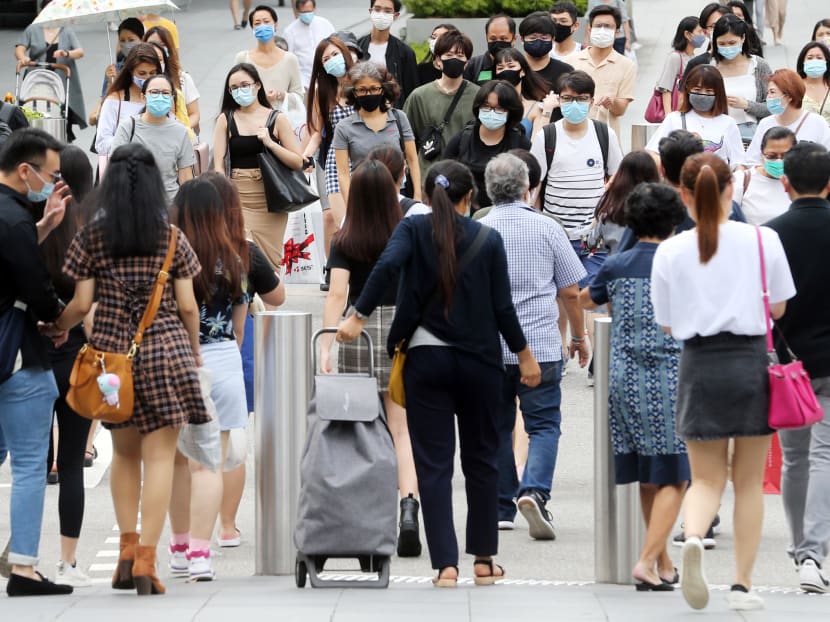7 in 10 employees got wage increases in 2021 as more firms turned profitable in rebounding economy: MOM
SINGAPORE — Seven in 10 employees got wage increases last year, up from just under six in 10 in 2020, as Singapore's economy rebounded and more companies were profitable, the Ministry of Manpower (MOM) said on Monday (May 30).

- Seven in 10 employees received wage increases in 2021, up from just under six in 10 in 2020
- This is because more companies are profitable, allowing them to restore wage cuts implemented in 2020
- These were some of the findings in the Ministry of Manpower's Report on Wage Practices 2021
- The ministry also said higher inflation in 2021 "dampened" real wage growth
- It expects the tight labour market to support continued wage growth in 2022
SINGAPORE — Seven in 10 employees got wage increases last year, up from just under six in 10 in 2020, as Singapore's economy rebounded and more companies were profitable, the Ministry of Manpower (MOM) said on Monday (May 30).
The ministry's Report on Wage Practices 2021 found that the proportion of profitable employers increased from 63 per cent in 2020 to 75 per cent in 2021.
"The strong recovery of Singapore’s economy and a tight labour market prompted more employers to raise their employees’ wages in 2021, following a period of wage moderation in 2020," MOM said in a press release.
It found that 70 per cent of employees received wage increases in 2021, up from 59 per cent in 2020. The extent of average wage increases was also higher in 2021 (6.3 per cent) than in 2020 (4.5 per cent).
The proportion of employees who received wage cuts last year more than halved to 10 per cent from nearly one in four employees, or 23 per cent, in 2020 as the Covid-19 pandemic took its toll.
These cuts were less steep, with those in 2021 getting a wage cut of 5.2 per cent on average, compared to 2020's 6.9 per cent cut.
TOTAL WAGE GROWTH 'DAMPENED' BY HIGHER INFLATION
MOM also found that among Singapore citizens and permanent resident employees who have been with the same employer for at least a year, total wage growth last year was 3.9 per cent, similar to that of 2019.
The wage growth, which includes employer Central Provident Fund contributions, is higher than the 1.2 per cent in 2020.
“The rebound in total wage growth in 2021 reflects the broad-based economic recovery across industries, and a tight labour market due to border restrictions slowing down the inflow of non-resident labour.Ministry of Manpower”
"The rebound in total wage growth in 2021 reflects the broad-based economic recovery across industries, and a tight labour market due to border restrictions slowing down the inflow of non-resident labour," MOM said.
It added that resident employment grew by 71,300, while non-resident employment fell by 30,000.
Although wage growth last year was lesser than the 5.9 per cent growth in 2010 — the year after the global financial crisis — MOM said that this suggests employers were still cautious about raising wages, fearing the longer tail of the Covid-19 pandemic.
The ministry also noted that Covid-19's impact on wages was "less severe" than that of the global financial crisis, so wage growth had less ground to recover.
"However, higher inflation in 2021 has dampened real wage growth, although wage growth has continued to exceed inflation," it added.
"The real wage growth of 1.6 per cent in 2021 was only slightly above that of 2020 (1.4 per cent) and lower than 2019 (3.3 per cent)."
Ms Yong Yik Wei, chief economist at the Ministry of Trade and Industry, on May 25 noted that nominal salaries will outpace inflation. Private sector experts also said that while wages growth is to be expected, some sectors will lag behind others.
On this point, MOM found that all sectors had experienced higher total wage growth last year, compared to 2020.
Total wage growth for outward-oriented sectors — such as information and communications (5.1 per cent), financial and insurance services (4.1 per cent) and manufacturing (4 per cent) — had "registered healthy expansion even in the midst of the pandemic and continued to see strong wage growth".
It also found that among domestic-orientated sectors, the retail sector had recorded the highest wage increase of 5.5 per cent.
"Sectors that were more affected by the pandemic also registered wage increases as demand for manpower rose in tandem with the reopening of the borders," MOM said.
For example, the food-and-beverages services sector recorded an average wage increase of 2.6 per cent in 2021, up from 1.5 per cent in 2020.
The ministry said that it expects the tight labour market to support wage growth this year, despite relaxed border restrictions allowing more non-residents to enter the workforce.
"However, downside risks in the global economy remain, such as the ongoing Russia-Ukraine conflict and protracted global supply disruptions, which could moderate demand and nominal wage growth.
"With recent shocks to the global supply chains, inflation is projected to stay elevated and dampen real wage growth."








